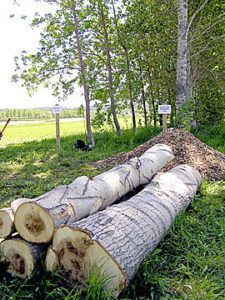 |
| Poplars harvested from shelterbelts can provide lumber, veneer and chips. The poplars are harvested just as they begin to compete with ash and oaks planted alongside them. This shelterbelt at Lakopita College Farm in LaPocatiere, Quebec, also includes a row of fir trees. |
Story and photos by Jean English
Agroforestry, according to Ron Smith of New Brunswick, is “managing trees and other stuff together.” This down-to-earth definition works well for Smith and clients of his consulting company, VarFor Ltd., which he founded after working for the Canadian Forest Service for 27 years. Smith discussed the great economic, environmental and social potential of agroforestry at the 10th North American Agroforestry Conference at Université Laval in Quebec in June 2007.
The “other stuff” brings a multiple-value, multiple-product, multiple-species approach to agroforestry, which includes planting windbreaks and hedgerows, alley cropping, silvopasture (pastures and trees growing together), riparian buffers (shoreland plantings that shade streams and reduce erosion and pollution) and forest farming. From 2003 to 2005, almost 600 miles of windbreaks were planted in Quebec, said Smith, representing “huge potential” from, for example, small fruits.
“Many non-timber forest products (NTFPs) can be grown in shade or partial shade,” Smith explained. Keys to increasing the economic value of a windbreak are to provide a habitat with depth, rather than a single row of trees of the same height; and not to think with a commodity mindset.
Smith illustrated the economic benefit of agroforestry in relation to blueberry production and Colony Collapse Disorder of commercial honeybees. Native bees are 10 to 100 times more efficient than honeybees at pollinating blueberries, he said, but the environment around monocropped blueberries does not support wild pollinators once blueberry flowers have faded. Adding (or leaving) an agroforestry component, however, can extend native pollinators’ feeding with serviceberry, beaked hazel, chokecherry, hawthorn, highbush cranberry and elderberry.
Nathan De Baets of the Centre d’expertise sur les produits agroforestiers in La Pocatiere, Québec, and Luc Bérard of the Ministere des Ressources naturelles et de la Faune, Québec, noted that strips of blueberries alternating with strips of Jack pine forests yielded more and suffered less wind damage than blueberries grown alone. Optimum production of both blueberries and wood seems to occur with 60-m-wide strips of blueberries and 42-m-wide strips of intensive forest planted in three bands: one to produce at 0 to 20 years of age; one at 20 to 40 years; and one at 40 to 60 years. (Research on spacing, orientation, etc., is ongoing; and available equipment can dictate spacing.) The pines reduce wind erosion and hold snow; and radiant heat trapped by forests during the day may protect against early and late frosts. These systems also supported more pollinating insects and more wildlife.
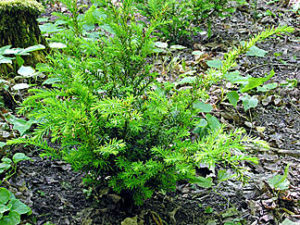 |
| Canada yew can be cultivated under deciduous forests with a canopy density of 50% or less (or more, if leaf litter is removed each spring). Ideal sites are close to water and slope slightly for good drainage. Deer and rabbits compete with humans for harvest; and competition with Chinese products is also occurring now. |
Prince Edward Island has strengthened its laws about planting near waterways, thus encouraging more riparian buffers – and movement of fertilizers from adjacent agricultural fields can help produce crops in these buffers. Canada yew (Taxus canadensis), for example, is grown for compounds called taxanes that treat breast and ovarian cancer, and sloping lands are ideal for this plant. The extensive extraction and purification of taxanes from needles, bark and roots of yews ensures a pure product, even if pesticides have been used near the shrubs.
Agroforestry can be useful under power lines, where planting low-growing, economic shrubs, such as juniper and Canada yew, can diminish or eliminate the need for herbicides.
Smith showed a gorgeous photo of rows of black walnut trees interplanted with flowering lavender; and of wheat fields with trees interplanted.
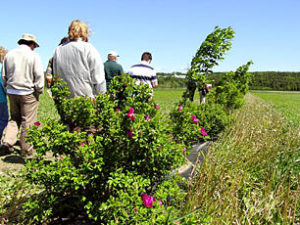 |
| Rugosa roses were planted among hardwoods in this experimental shelterbelt in LaPocatiere. Other experiments include truffles with nut trees; elderberries, chokecherries, and highbush cranberries. |
Shrub roses (such as Rosa rugosa) planted in a shelterbelt can provide rose hips, which, added Smith, are high in lycopene, a compound that may help fight prostate cancer.
Maple syrup producers typically eliminate undergrowth in their sugarbushes; however, Smith continued, sugarbush lands are perfect for cultivating Canada yew. Shiitake mushrooms can also be grown under forest canopies.
New uses for common forest species can increase the value of a woodland. The Alaskan government has put a lot of money into developing a birch syrup industry, for example. Tapping and boiling down are the same as for maple syrup, but birch syrup has a little less sugar, is more tolerable for diabetics, and is significantly underutilized.
Agroforestry can help alleviate climate change while adding income to farms. A Canadian Forest Service program called Forest 2020 promotes planting underutilized farmland for carbon credits. Smith wonders whether a multispecies planting might sequester more carbon than a single species. The Forest Service has identified 30 species with NTFP potential, such as blackberries for fruit; sweet fern and juniper for essential oils; and sumac for cane furniture.
Agroforestry provides habitat for wildlife – a double-edged sword, noted Smith, since deer and moose love to feed on Canada yew.
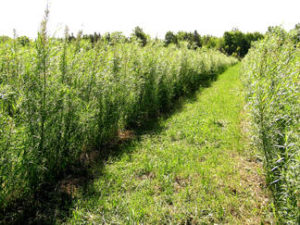 |
| An experimental plantation of willow grown for biomass. |
Growing Energy
Agroforestry can also produce woody biomass for energy – the subject of a talk by Edwin White of SUNY College of Environmental Science and Forestry in Syracuse, New York. Instead of mega farms producing ethanol from corn, he suggested that 200- to 500-acre bioenergy farms might be better – for the energy produced and for rural development. He envisions locally adapted species, including southern pine in the Southeast, willows in the Northeast and Douglas fir in the Northwest. Ethanol derived from corn takes 1 Joule (J) of energy put into the system to get from 1 to 1.67 J out (at best), while short-term willow rotations produce 55 J at the farm gate for each Joule invested, or 11 to 16 J at the power plant (subtracting the energy used to produce and transport the feedstock and build the power plant).
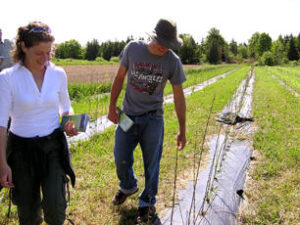 |
| Willow cuttings taken in the fall and stored in the freezer over winter can be stuck through plastic mulch in the spring. |
In New York, White and his coworkers have experimented with planting double rows of willows, as is done in Europe; coppicing the shrubs at the end of the first growing season; and harvesting three years after coppicing, using a mechanical harvester/chipper developed with New Holland. Chips can then be used for fuel stock, bioplastics and other goods.
Woody biomass also serves as snow fencing, as shelter for pheasants and other wildlife, and as riparian buffer strips that reduce the nitrogen and phosphorus entering streams. (New York allows harvest of willows from Conservation Reserve Program lands.)
As they stop water from leaching through landfills, willows can be the final step in cleaning up such sites.
Seven willow clones have been developed that grow about 30% faster than common clones, White added. Biomass from these plants can be available year-round from sustainably managed plots.
Philippe Savoie of Agriculture et Agroalimentaire Canada in Québec talked about harvesting short-rotation willows with a cutter-shredder-baler that he and others have developed. Trees are grown in three-year rotations, up to 6 m in height. They have a moisture content of 45 to 50% and produce 30 to 60 tons of dry matter per hectare. They’re grown in single rows 1.5 m apart. (Europeans grow in double rows, 0.75 m between two rows, and 1.5 m between sets of double rows.) European harvesters produce chips, said Savoie, but the machines are very expensive.
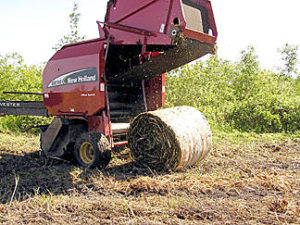 |
| A New Holland hay baler was adapted to bale willow (or other shrubby growth) grown for biomass. |
A smaller, less expensive harvester would need to harvest stems up to 80 mm in diameter, and shred and bale them. Canadian engineers have modified a round hay baler so that it is offset from the tractor (so the tractor doesn’t drive over the willow shrubs); the axle was moved forward to improve balance; cutting blades were replaced with cutting saws; the height is adjustable; and hammers behind the cutting saws soften the willow stems so that they can be baled.
The cost of the improved baler was $50,000 Canadian. One or two more modifications are needed before it can be commercialized, but Savoie concluded that it is feasible to cut, shred and bale willow with a single machine and a 100-120 kw tractor with four hydraulic circuits.
During a field trip to Saint-Jean-Port-Joli, conference participants saw basket willow (Salix viminalis) cultivated for biomass (for biofuel) and for crafts. Researchers are looking for clones and species that yield at least 15 dry tons per hectare. Typically, 20 cm cuttings are planted at a rate of 18,000 cuttings per hectare; they’re coppiced, then grown for three years before harvest. The planting lasts for at least six or seven rotations before production decreases.
White concluded, “We need biomass feedstocks and local refineries. I think we’re there. We’re killing too many people around the world and we’re killing our own people. We [the agroforesters] are really the people who are needed. We’re in the right place at the right time. Keep doing what you’re doing.”
Long-Term Research at Guelph and Beyond
A considerable amount of work on willow biomass has also occurred at the University of Guelph Agroforestry Research Station in Ontario, which has the largest continuous (22-year) study of agroforestry plants in the world, with 10 tree species growing at two row widths (12 and 15 m) intercropped with three annual crops on six soil types using four replicates.
Guelph researchers have also planted riparian buffers in degraded fields along streams and have seen a big drop in solar radiation hitting the streams, and in nitrogen moving into the streams. Andrew Gordon of the Department of Environmental Biology at Guelph noted “the invisible present” of these systems – “the complexity related to the structure and function of ecosystems that is hidden to us.” He urged agroforesters not to “lose sight of the long-term important role trees play.” To secure funding for such projects, he suggested asking what you want to find out in 20 years, then going for short-term funding. “Be tenacious,” he advised.
Naresh Thevathasan of the University of Guelph noted that agroforestry projects in Ghana, Chile and Nepal quadrupled the income of women who participated, and increased food security.
Thevathasan found that orienting tree rows along a northwest-southeast line gave the greatest solar radiation on cropping alleys between the trees in southern Ontario. (A northeast-southwest orientation would be best in Patagonia, he noted.)
While trees are becoming established – for at least the first five years – Thevathasan said to avoid planting early season agricultural crops (spring barley, winter wheat) in the alleys; corn would be better, because it doesn’t deplete soil moisture early in the season. He also noted that wheat and beans yielded about as much in agroforestry systems as in open fields; but corn yielded less, because its C4 photosynthetic pathway requires more light than plants that metabolize carbon using the C3 pathway.
Weeds should be controlled within tree rows. A study using a control, poplar leaf mulch, wheat straw and Roundup showed that wheat straw gave the best control, said Thevathasan.
The Guelph research has found two zones among trees planted in rows 15 m from one another: a 2-m-wide zone on either side of the tree row, where competition for light and water exists; and a complementary zone in the remaining 11 m where crop growth is enhanced through nutrient cycling, N mineralization, additional soil organic carbon, greater earthworm activity (especially in hybrid poplar-based systems), lower soil temperature, low evapotranspiration and reduced wind turbulence. Bird and insect diversity (including parasitoids) are also increased.
In a hybrid poplar-based intercropping system, four times more C was sequestered than in a conventional agricultural field. (Forty-year-old hybrid poplars sequester an estimated 40 metric tons of C, said Thevathasan; Norway spruce would take 70 years to sequester the same amount.) Nitrate leaching has been reduced by up to 50%, and E. coli populations have been reduced by up to 40% in tree-based intercropping systems compared with conventional, monocropped row crops. These results occurred even with a fairly low density of 111 hybrid poplars per hectare.
The complementary zone could grow willow hybrids between, for example, rows of black walnut trees. Such a trial was established at Guelph in 2006, with the hypothesis that the favorable conditions in the complementary zone will enhance short-term rotation biomass production relative to willows planted without walnut trees.
Some agroforestry practices date to Roman times, noted Fabien Liagre, who has a consulting firm called Agroof Développement in Anduze, France. Interest in the subject is growing quickly now due largely to the results that the European Program SAFE (Silvoarable Agroforestry for Europe) achieved in 2005. A new national program, begun in 2006 (see www.agroforesterie.fr), aims to establish about 300 plots by 2008 on different kinds of land and with various species, including interplanting trees with flowers and shrubs, and making Ramial Chipped Wood (RCW) from small branches. Liagre said that one-third of those in the project are organic farmers who are not so interested in hybrid poplars or walnut, but in the agronomic consequences by introducing trees inside the parcels.
Cees van Oosten of SilviConsult Woody Crops Technology Inc., in Nanaimo, British Columbia, provided information about typical planting densities for hybrid poplars worldwide:
| Purpose | Stems per Acre | Years of Growth |
| Biomass | 400 or more | less than 7 |
| Pulp or Oriented Strand Board | 400-485 | 7-12 |
| Saw or Veneer | 80-120 | 15-30 |
Van Oosten noted that densities between 160 and 485 stems per acre have not been well studied. Typical densities for hybrid poplar biomass, he continued, are double rows that are 75 cm apart, with 2.8 m between sets of double rows. Spacing for pulpwood is typically 3 x 3 m; for saw logs and veneer logs, 5 x 5 to 7 x 7 m in Europe and South America (with lower limbs pruned).
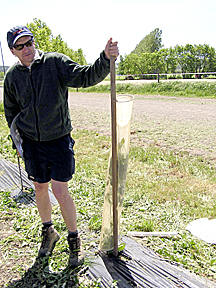 |
| This mesh bag protects young trees from damage by deer, but costs $5. |
The growth rate of the diameter (at breast height) of hybrid poplars in Oregon and British Columbia peaks when trees are three years old, then declines, so good weed control is important then, as are improved clones.
A wide range of densities will produce similar volumes; however, the proportion of higher value saw logs and veneer logs increases with a lower density. In the Prairie Provinces of Canada, current recommendations for best returns are 650 to 770 stems/ha for unpruned trees and 434 to 770 stems/ha for pruned trees. More information is available from the Poplar Council of Canada or the Saskatchewan Forest Centre.
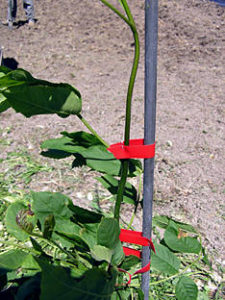 |
| Planting a tree alongside a metal bar, costing $1, is a more economical method of keeping deer from nibbling trees. |
Regarding weed control, Michael Demchik of the University of Wisconsin-Stevens Point trialed a killed cover crop of sorghum-Sudangrass as an alternative to expensive herbicides and to environmental consequences of establishing hybrid poplars on bare, marginal lands or by streams. In 2001, for example, the cost of tillage and herbicides in the first year of poplar growth was $90/A ($140 now, adjusted for inflation); in the second year it was $50. So, “30 to 50% of the cost of growing the crop is in tillage and chemicals,” said Demchik. Sorghum-Sudangrass, in addition to smothering weeds, produces about 10 tons of dry biomass per acre.
Demchik planted the cover crop in late June 2001, sickle bar mowed the winterkilled crop the following spring, then easily planted NM6 hybrid clones through the 4-inch-deep residue with a planting bar. In the cover-cropped plots, 85% of trees survived, versus 51% in conventionally prepared plots. (This was a dry year.) Weeds were minimal in the cover cropped plots, and Demchik concluded that the cropping system would eliminate the need for weed control in the first year and would probably reduce it significantly in following years.
Riparian Forest Buffers
Richard Lowrance of the USDA-Agricultural Research Service in Tifton, Georgia, described riparian forest buffers (RFBs) as planned or unplanned combinations of trees, shrubs and herbaceous vegetation adjacent to streams in agricultural settings. They can provide habitat and food for wildlife and generate income as they filter sediment, nutrients, pesticides and other contaminants from surface runoff and subsurface flow; provide shade, detritus and large woody debris to aquatic ecosystems; and stabilize stream banks and reduce flood velocities.
These buffers can be relatively narrow if they’re just controlling erosion on stream banks, or wider for wildlife habitat. They include three zones – the undisturbed forest (usually hardwoods) along the streambed or bank; a zone of managed forest (usually softwoods) that can provide farm income; and a zone of grasses that serves as a filter strip. Such systems can retain about 60% of the nitrogen and phosphorus moving to them over 10 years.
Michael Gold of the Center for Agroforestry at the University of Missouri has been working in agroforestry for about 20 years, and he sees the field being increasingly recognized now, comparing it with the huge growth in demand for organic, local foods, despite limited government support. One factor feeding the interest in riparian buffers is the Dead Zone in the Gulf of Mexico. Riparian buffers can help minimize the movement of pesticides and nutrients from row-cropped fields into the Mississippi and its tributaries, and shrubs in those buffers can be harvested for the floral market. A well managed planting can gross $800 to $2,000 per 1000 feet – through harvesting pussy willow branches, for instance.
A Missouri program called Dogwood Carbon Solutions encourages farmers to plant trees to counter greenhouse gas emissions and to earn money for that from the Chicago Climate Exchange. One Missouri farmer, for example, planted 430 acres of loblolly pine and 170 acres of hardwoods in 1990. He sells pine needle mulch from the softwood plot and recently signed a contract to broker his carbon sequestration credits through Dogwood Carbon Solutions. He’ll earn $30/A/year for his pines and $15/A/year for his hardwoods.
Two programs at Missouri can serve as national models: One screens plants for best production under low-light conditions. “Someone should do this for corn,” said Gold. Another is a distance agroforestry education program.
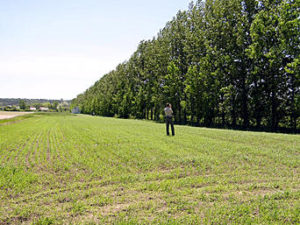 |
| A shelterbelt at Lapokita College in Québec. |
Shelterbelts
William Schroeder of Agriculture and Agri-Food Canada at Indian Head, Saskatchewan, defined shelterbelts as barriers of trees and shrubs that protect against wind erosion. Windbreaks, he said, are hedges or nonliving fences that break the force of wind; and hedgerows are boundaries formed by hedges – a term used almost since the Middle Ages. All can be considered shelterbelts.
Shelterbelts can arise spontaneously when farmers let woody plants “crop up”; when they strategically leave some woody plants for shelter; or they can be planted. Single rows of caragana (Siberian peashrub) are common in Western Canada for windbreaks, erosion control, and protecting homes and livestock.
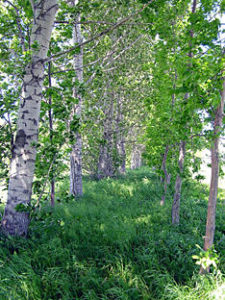 |
| Poplar (left) and oak trees in the shelterbelt at Lapokita College. Lower branches are pruned over time, and tops are pruned when the trees are young to ensure that they have just one strong central leader. |
Well-constructed shelterbelts affect microclimates dramatically, Schroeder continued, saving about 25% of the energy needed to heat farm buildings. While they are still planted primarily to reduce wind speed, their ecological benefits are increasingly recognized and should be studied more. Their biodiversity provides tremendous opportunities for Integrated Pest Management and for native pollinators. They intercept particles and sequester carbon.
Anne Loeffler of the Grand River Conservation Authority in Cambridge, Ontario, told about partnering between the hog industry and agroforesters to reduce odors by 25 to 33%, as shelterbelts settle out dust. The shelterbelts also lowered the heating costs for the barns, and made farmsteads more attractive.
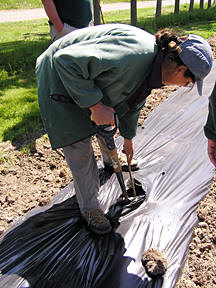 |
| Poplar trees root readily and can be planted through black plastic mulch using a tree planting shovel. Most shelterbelts in Quebec have been established in black plastic, which lasts at least five years and enhances tree survival and reduces maintenance. |
These shelterbelts typically consist of hybrid poplars planted through strips of black plastic mulch for weed control, moisture retention, higher survival rates and faster growth. Loeffler said that soils should be well prepared (one site was rototilled three times) and have no rocks or curves, to ensure proper mulch laying. Once this system was developed, a Farmstead Shelterbelt publication was sent to every hog producer in Ontario. (See wbvecan.ca.)
Herbaceous Woodland Plants
Harvesting fern fronds for the floriculture industry is one use of herbaceous woodland plants, said Jim Chamberlain of the USDA National Agroforestry Center in Blacksburg, Virginia.
Greg Wortman of the Université de Moncton in Edmundston, New Brunswick, is experimenting with growing Indian cucumber root (Medeola virginiana) in sugar maple stands in northwestern New Brunswick. He has found that planting larger rhizomes produced more “clones” (branches on rhizomes) than planting smaller rhizomes. The amount of shade did not influence yield. This popular ornamental has an edible rhizome that was eaten by Native Americans, was used in fishing, and can be preserved in vinegar or used in bread.
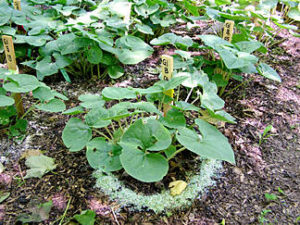 |
| Wild ginger is grown for its root, which contains an aromatic essential oil that smells strongly of ginger. The leaves also taste of ginger and are used as a condiment, and wild ginger is used in worm tablets for animals. The plant has widely recognized antibacterial properties. Wild ginger grows almost exclusively in maple forests in northeastern North America (such as the one at the Beaupré Woodlot, shown here, in La Pocatiere) and requires a moist, rich, well-drained soil. Rhizomes need to be planted shallowly to prevent rotting; then the soil should be mulched with leaf litter or compost. The first roots are harvested after four or five years. Crushed glass (shown here), diatomaceous earth and iron sulfate are being tested for slug control. |
Julie Naud of the Université Laval in Quebec found that increased light in sugar maple forests produced increased growth of black cohosh (Actaea racemosa), wild ginger (Asarum canadense), blue cohosh (Caulophyllum thalictroides), bloodroot (Sanguinaria canadensis), Canada maidenhair fern (Adiantum pedatum), Ostrich fern (Matteuccia struthiopteris) and white trillium (Trillium grandiflorum). She suggested that forest openings could be appropriate places for their cultivation, producing greater total yields of active compounds in the medicinal species. Some of these species are sensitive to low pH and to excess aluminum in soils. Slugs were problematic on some, as well.
Jeanine Davis of North Carolina State University Mountain Horticultural Crops Research and Extension Center in Fletcher, N.C., noted that sales of herbs and botanicals reached $4.4 billion in 2005, creating pressure on wild plant populations and promoting cultivation. “Manufacturers are looking for quality,” she said. Imports tend to be of lesser or unreliable quality and elicit concerns about food safety. The focus at N.C. State is on teaching growers about producing certified organic products that are tested for heavy metals (and pesticides if they’re grown in suspect areas, such as old tobacco land), are analyzed for medicinal components or for their markers; are produced according to Good Agricultural Practices (GAPs) and processed according to Good Manufacturing Practices (GMPs).
Davis noted the following as being of interest and/or in demand currently (and some are valuable plants for shady landscapes):
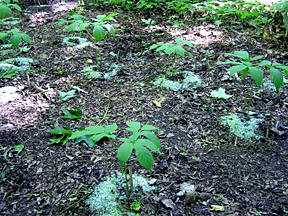 |
| Wild ginseng is being studied in the deciduous forest at the Beaupré Woodlot in LaPocatiere. Wild harvest of the native herb has reduced its populations dramatically. A well-drained site with few or no stones, with a pH of 5.5, and with 70 to 80% shade is best. |
• Ginseng (Panax quinquefolius), which can be wild, woods-grown; wild-simulated; or grown in artificial shade. It is propagated by seed usually, or seedlings are transplanted. It improves mental activity, fertility and stress tolerance, and is being used in cancer research.
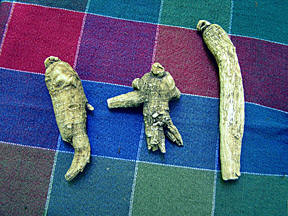 |
| Ginseng roots are harvested eight to 10 years after seed is sown. |
• Goldenseal (Hydrastis canadensis), endangered in North Carolina, is harvested for its perennial rhizome. It is easy to propagate from cut rhizomes and from seed. It contains the medicinal compounds hydrastine, berberine, canadine and others; has been used as a topical antiseptic and to fight fungal infections on skin; is a synergistic herb (improves the efficacy of other herbs); and reputedly masks illegal drugs in urine tests. Although goldenseal is “the poster child for United Plant Savers,” said Davis, and CITES regulates international trade of the herb, most goldenseal is still wild-harvested.
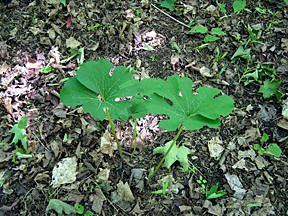 |
| Bloodroot is another medicinal herb that can be grown in deciduous forests. |
• Bloodroot (Sanguinaria canadensis) is a perennial that is propagated by seed and rhizome cuttings. Almost all bloodroot on the market is wild-crafted. It has been used traditionally as a dye; to treat skin lesions; and to prevent tooth decay (it was formerly in the toothpaste Viadent). Now it is being studied as an appetite stimulant in cattle feed; and it’s used in cancer studies. Sanguinine in the herb has antimicrobial properties.
• Black cohosh (Actaea racemosa) is propagated by division or seed. An alternative to hormone replacement therapy for women, it is in high demand and some is cultivated – but the price paid for the herb has not increased with the demand.
• Blue cohosh (Caulophyllum thalictroides) helps women in childbirth. It is slow growing but easy to cultivate and is propagated by seed and division. The herb is not in high demand and is not commercially cultivated yet on a large scale. “It’s a beautiful landscape plant in a woodland garden,” said Davis.
• False unicorn (Chamelirium luteum) is quite rare and slow growing; commercial production is just starting. This women’s herb helps alleviate pain and poor appetite. Davis has had trouble growing false unicorn in North Carolina but has seen good stands in southern Ohio.
• Mayapple (Podophyllum peltatum) is being used in cancer research.
• Wild ginger (Asarum canadensis) grows in cool, shaded, moist woods; is propagated by division; is a stimulant and relieves intestinal gas.
Davis is researching efficient production systems for farmers; effects of the environment on bioactive constituents; marketing (just a handful of suppliers serve the big commercial outlets; there really isn’t a shortage of material on the wider market, said Davis; but there is potential for growers to market locally); economics and enterprise budgets.
As an example of her research, Davis noted that adding calcium to North Carolina soils reduced dry weight and increased foliar diseases of goldenseal, and tended to reduce medicinal alkaloids (but not statistically significantly so). The herb showed little response to added N or P fertility, although excess N produced smaller roots with lower concentrations of alkaloids; so Davis recommends low rates of N and P fertilizers, preferably from organic sources. The herb responds dramatically to increased pH, and the higher pH soils of Tennessee produce better stands of goldenseal than the naturally low pH soils in North Carolina. However, the alkaloids are more concentrated when the herb grows at lower pH levels – possibly a response to stress. Davis recommends a pH of about 5.8.
The best spacing for goldenseal is 6” x 6” or 6” x 4”. Leaf litter and hardwood bark are the best mulches; straw is bad in western North Carolina, although this response is site-specific. The greatest alkaloid concentration occurred in herbs grown under 30% shade, but the highest return (greatest amount of alkaloids per acre) and greatest dry weight was achieved with 63% shade. Davis supplied goldenseal to colleagues, who found that whole root water extracts inhibited the growth of cancer cells; the response depended on the dose and on the cell line type.
Gross income from growing goldenseal for four years can range from $14,400/A (for 800 lbs. of dried root, the lowest yield Davis sees, sold at $18/lb.) to $80,000/A (for 2,000 lbs. of certified organic crop sold at $40/lb.).
In 1994, 10 acres of goldenseal were cultivated in the United States; in 1998, 140 acres; in 2004, 119 acres.
Another research project developed an herb dryer that growers could produce for about $2,000, and a smaller unit costing about $500.
Keys to successful woodland herb productions are, said Davis:
- shade (mixed hardwood is best)
- good air and water drainage
- rich soil
- soil amendments as needed
- knowing which herbs grow well in the woods and which in artificial shade
- building raised beds in the woods
- obtaining quality seed or rhizomes
- realizing that seeds may take several years to germinate
- mechanizing cultivation as much as possible
- using a good organic mulch (oat straw has not worked for Davis)
- preventing pests
- collecting and stratifying your own seed over time
- realizing that these herbs may take three to eight years before harvest
- washing, drying and packaging according to buyers’ specifications
- marketing – “the hardest part.” Many growers’ co-ops have been successful.
“It takes about seven years to be a proficient goldenseal grower,” Davis concluded, adding that cultural methods should be studied in different locations. Goldenseal can probably grow with more light in Ontario than in North Carolina, for instance.
More NTFPs
James Chamberlain added to the list of non-timber forest products:
- woody crafts – bowls, birdhouses, vine baskets (from kudzu, grapevines and smoke vine), wreaths
- underutilized trees, such as sassafras. Until it was labeled as carcinogenic, the root bark of sassafras was used as a flavoring and medicinal; trunks are still used as walking sticks and for furniture; and the wood and bark yield a yellow dye.
- edible and culinary products, such as wild onions or leeks (Allium tricoccum) harvested for spring ramp festivals, which are big fundraisers in the mid-South; fruits used for jellies and jams; and edible mushrooms – although Chamberlain suggested diversifying away from shiitakes and producing higher-priced, less common species.
- florals and decoratives, which probably have the greatest market potential. These include plants for landscapes, and floral crops such as pussy willow and curly willow stems.
- longleaf pine for needles (for pine straw and baskets), decorative cones, sap, terpentine, oil, tar, and as a silvopasture species, with cattle grazing under pine trees.
- landscape plants, such as bloodroot, black cohosh, rhododendron, azalea and mountain laurel
- Christmas trees; growers can diversify into roping, garlands and tips for increased income, and can produce bareroot stock for the Christmas tree industry.
- herbs used as medicinals and dietary supplements, such as ginseng.
- David Trotter of the Ministry of Agriculture and Lands in Abbotsford, BC, added his list:
- cattle grazing between rows of aspens
- hybrid poplar interplanted with forage seed crops
- hawthorn grown for its medicinal value
- enhancing stump culture of Christmas trees (i.e., enabling Christmas trees to “grow back” from the stump after the initial tree has been cut)
- planting Christmas trees and forage crops together (possibly lengthening the grazing season)
- tapping bigleaf maples (Acer macrophyllum) in western North America
- interplanting hybrid poplar plantations with shade-tolerant NTFPs
- cultivating black truffles, hazelnut and oak together
Policy
Bob Turnock of Agriculture & Agri-Food Canada in Indian Head, Saskatchewan, talked about policies that can advance agroforestry. Including “Environmental Goods and Services” (EGS) values in conversations will help, he said. These include clean water, wildlife habitat, better grazing land, increased tourism and recreation, better pest control and pollination, spiritual and cultural values, climate regulation and flood reduction. Huge potential for adopting agroforestry exists if EGS can be quantified. “The concept of planting trees to increase agriculture and sustainable productivity is not understood,” Turnock said. “We need clear language to influence policy makers.”
Jean-Louis Daigle of the Eastern Canada Soil and Water Conservation Centre in Saint-André, New Brunswick, suggested on-farm demonstrations (of the importance of hedgerows in blueberry and potato production, for instance), workshops, information sessions, applied training, technical support and other activities to increase awareness of agroforestry. Impediments include the low availability of trees and shrubs; inadequate funding; and prohibitions against planting in certain areas.
David Trotter recommended branding agroforestry techniques (with logos, for instance) to get more attention.
| Community Supported Agroforestry? An article entitled “Tree Farming” by John Duvenaud (Acres U.S.A., May 2007) described a system for generating income from trees in the Canadian prairies. During the 1990s, Duvenaud says, he made $5 to $10 per acre growing grain – or even lost up to $25 per acre. He has turned to selling green ash trees grown on his property for $200 each. Customers might be grandparents buying a tree for a new grandchild, who might harvest the tree and have it made into furniture when he or she is 50 years old. Tree owners receive a certificate of ownership but do not have the right to visit the tree. While the tree grows (and even when it’s made into furniture), it captures or holds CO2, helping Canada meet its Kyoto commitment. For more information, see www.treefarm.ca. |
Next Conferences
The 11th Association for Temperate Agroforestry Conference will take place from May 31 to June 3, 2009, at the University of Missouri Center for Agroforestry in Columbia, Missouri. The 2nd World Congress of Agroforestry will take place from Aug. 20-24, 2009, in Nairobi, Kenya.
Resources
Association for Temperate Agroforestry, c/o Center for Agroforestry, 203 ABNR, University of Missouri, Columbia MO 65211; [email protected]; www.centerforagroforestry.org, or www.aftaweb.org.
Davis, Jeanine, Dept. of Horticultural Science, North Carolina State Univ., Mountain Horticultural Crops Research and Extension Center, 455 Research Dr., Fletcher NC 28732; [email protected]; ncspecialtycrops.org/medherbs
Dixon-Warsen, Heloise, The Birch Syrup Production Manual, Quesnel Community & Economic Development Corp., 2007, www.quesnelinfo.com
Eastern Canada Soil and Water Conservation Centre, 1010 chemin de l’Église, Saint-André, NB, E3Y 2X9, Canada; www.ccse-swcc.nb.ca
Federation of British Columbia Woodlot Associations, www.woodlot.bc.ca/
Hybrid Poplar Crop Manual for the Prairie Provinces, www.saskforestcentre.ca (under Reports and Technical Sheets); www.poplar.ca/whatsnew.htm
Nair, P.K., M.R. Rao and L.E. Buck, eds., New Vistas in Agroforestry, A Compendium for the 1st World Congress of Agroforestry, Kluwer Academic Publishers, 2004.
Junaki, Ed, R.R. Alavalapati and D. Evan Mercer, Eds., Valuing Agroforestry Systems, Methods and Applications, Kluwer Academic Publishers, 2004.
Poplar Council of Canada, www.poplar.ca
University of Missouri Center for Agroforestry, www.centerforagroforestry.org/
Whiten, Reg C., Boreal Forest Bounty: A Botanical Species Resource Guide for Conservation Enterprise Development, coming from Trafford Publishing, Victoria BC; www.trafford.com
